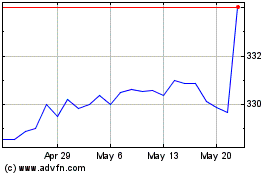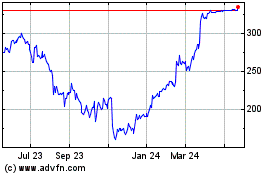Shockwave Medical, Inc. (NASDAQ: SWAV), a pioneer in the
development of Intravascular Lithotripsy (IVL) to treat severely
calcified cardiovascular disease, today unveiled new data
confirming the safety and effectiveness of coronary IVL out to one
year, a new gender analysis that found similar outcomes between men
and women, and an OCT analysis that found consistent acute
performance in eccentric, concentric and nodular calcified lesions.
The data from the Disrupt CAD clinical program were presented in
several sessions at the 32nd Transcatheter Cardiovascular
Therapeutics (TCT) annual scientific symposium of the
Cardiovascular Research Foundation, in Orlando, Fla.
First One-Year Outcomes Find Durability of Excellent
Procedural Results The first one-year outcomes from the
prospective, multicenter, single-arm, global investigational device
exemption (IDE) Disrupt CAD III study demonstrated low rates of
major adverse cardiovascular events (MACE, 13.8 percent) and target
lesion failure (11.9 percent). The MACE results were primarily
driven by the rate of non-Q wave myocardial infarction (9.2
percent), demonstrating durable safety and effectiveness following
lesion preparation with IVL prior to stent deployment. The MACE
rate included low rates of cardiac death (1.1 percent), myocardial
infarction (10.5 percent), and target vessel revascularization (6.0
percent) one year after the index procedure. In addition, target
lesion revascularization (TLR), occurred in only 4.3 percent of
patients and definite or probable stent thrombosis occurred in 1.1
percent of patients at one year, with only one patient having a
definite or probable stent thrombosis beyond 30 days, resulting a
late stent thrombosis rate of at 0.3 percent.
“It is very significant that these data show sustained and
persistent relative benefit of IVL for lesion preparation prior to
coronary stenting, particularly since this is the first robust
one-year report that has been presented on the technology,'' said
Dean Kereiakes, M.D., FACC, FSCAI, Medical Director of The Christ
Hospital Heart and Vascular Center and the Christ Hospital Research
Institute; Professor of Clinical Medicine, The Ohio State
University; Co-Principal Investigator of Disrupt CAD III. “The
achievement of an average stent expansion of 102 percent and a
minimum stent area (MSA) of 6.5mm2 at the index procedure with IVL
should have predicted excellent long-term results. We were
optimistic that there should be a low rate of late target lesion
revascularization and stent thrombosis to one year, and that is
exactly what we found following IVL.”
OCT Analysis Finds
Similar MSA and Stent expansion Across Calcium
Morphologies A pooled analysis of 262 patients enrolled in
OCT sub-studies from Disrupt CAD I, II, III, & IV, the largest
intravascular imaging analysis of any calcium modification tool to
date, confirmed that coronary IVL achieved excellent MSA and stent
expansion (SE) consistently in lesions with both eccentric and
concentric calcium. MSA and SE at the maximum site of calcification
were similar across the four calcium arc quartiles analyzed: ≤180°
(6.1mm2 & 104%), 181-270° (6.0mm2 & 101%), 271-359° (6.1mm2
& 98%) and 360° (6.2mm2 & 105%), respectively.
In a separate analysis of calcific nodules, coronary IVL was
found to have a notable acute effect on calcific nodules, which
were identified in 22 percent of cases, either by flattening or
fracturing the nodule, resulting in consistent MSA (6.3mm2 vs
6.0mm2) and SE (101% vs 103%) in lesions with calcified nodules
(n=54) or those without (n=194), respectively. The analysis also
found that calcific nodules, defined as an accumulation of nodular
calcification, or small calcium deposits, with disruption of
fibrous cap on the calcified plate, were more commonly associated
with concentric calcium and greater overall calcium burden.
“The ability to modify calcium regardless of its morphology,
whether eccentric, concentric or nodular, and have MSA and stent
expansion still remain consistent shows the versatility of IVL to
make a meaningful impact on clinical practice,” said Ziad Ali,
M.D., DPhil, Director of the DeMatteis Cardiovascular Institute and
Investigational Interventional Cardiology at St Francis Hospital
& Heart Center, and presenter of the data at TCT. “To date all
OCT analyses of IVL reveal that the greater the calcium burden, the
greater the number of fractures. These data now show that evidence
of visible fracture by OCT is not necessary to achieve large MSA or
adequate stent expansion, particularly in these unique, but
clinically relevant sub-groups of calcification. The take home
message is that IVL liberates vascular compliance in all sub-groups
including eccentric lesions and calcified nodules.”
Coronary IVL Found Equally Safe and Effective in Men and
WomenA pooled analysis of the Disrupt CAD I, II, III,
& IV studies showed IVL was equally safe and effective in men
and women, unlike previous findings with atherectomy.i The analysis
of 628 patients stratified outcomes by sex. Women in the analysis,
who accounted for 23 percent of total patients, were older and more
likely to have hyperlipidemia, renal insufficiency and prior
myocardial infarction. Despite more frequent comorbidities and
smaller vessel size in women, the primary safety endpoint of 30-day
MACE for women and men was similar (8.3 percent vs 7.1 percent,
p=0.61). The primary effectiveness endpoint of procedural success
for women and men was also similar (91.7 percent vs 92.6 percent,
p=0.72). Notably, there were also consistent post-IVL serious
angiographic complications between women and men (1.6 percent vs
2.3 percent, p=0.75), which differs from previous atherectomy
gender analyses.
“Given the strong safety profile of IVL and the known higher
risks of women undergoing PCI, coronary IVL is an attractive option
for optimizing outcomes in female patients,” said Alexandra Lansky,
MD, FACC, FAHA, FSCAI, FESC, Professor of Medicine (Cardiology);
Director of Yale Cardiovascular Clinical Research Program Yale
University School of Medicine, New Haven, CT. “While this is the
first analysis of its kind for coronary IVL, it is highly
suggestive that the technology could potentially serve as
first-line therapy for women with calcified lesions, particularly
if these findings can be confirmed in a larger patient cohort.”
Summarizing the totality of the data presented at TCT, Dr.
Kereiakes commented, “Looking at these data holistically, it
doesn’t matter whether you're in Europe, Japan or the U.S. It
doesn’t matter if you're in a big center, or little center. It
doesn’t matter which type of calcium or which type of patients
you’re treating. The beauty of these data are the consistency of
safety and effectiveness. We found no differences with IVL. For
these reasons I call IVL the great equalizer.”
About Shockwave Medical, Inc.Shockwave is
focused on developing and commercializing products intended to
transform the way calcified cardiovascular disease is treated.
Shockwave aims to establish a new standard of care for the
interventional treatment of atherosclerotic cardiovascular disease
through differentiated and proprietary local delivery of sonic
pressure waves for the treatment of calcified plaque, which the
company refers to as Intravascular Lithotripsy (IVL). IVL is a
minimally invasive, easy-to-use and safe way to significantly
improve patient outcomes. To view an animation of the IVL procedure
and for more information, visit www.shockwavemedical.com.
Forward-Looking StatementsThis press release
contains statements relating to our expectations, projections,
beliefs, and prospects, which are “forward-looking statements”
within the meaning of the Private Securities Litigation Reform Act
of 1995. In some cases, you can identify these statements by
forward-looking words such as “may,” “might,” “will,” “should,”
“expects,” “plans,” “anticipates,” “believes,” “estimates,”
“predicts,” “potential” or “continue,” and similar expressions, and
the negative of these terms. You are cautioned not to place undue
reliance on these forward-looking statements. Forward-looking
statements are only predictions based on our current expectations,
estimates, and assumptions, valid only as of the date they are
made, and subject to risks and uncertainties, some of which we are
not currently aware.
Important factors that could cause our actual results and
financial condition to differ materially from those indicated in
the forward-looking statements include, among others: the impact of
the COVID-19 pandemic on our operations, financial results, and
liquidity and capital resources, including the impact on our sales,
expenses, supply chain, manufacturing, research and development
activities, clinical trials, and employees; our ability to develop,
manufacture, obtain and maintain regulatory approvals for, market
and sell, our products; our expected future growth, including the
size and growth potential of the markets for our products; our
ability to obtain coverage and reimbursement for procedures
performed using our products; our ability to scale our
organizational culture; the impact of the development, regulatory
approval, efficacy and commercialization of competing products; the
loss of key scientific or management personnel; our ability to
develop and maintain our corporate infrastructure, including our
internal controls; our financial performance and capital
requirements; and our ability to obtain and maintain intellectual
property protection for our products, as well as our ability to
operate our business without infringing the intellectual property
rights of others. These factors, as well as others, are discussed
in our filings with the Securities and Exchange Commission (SEC),
including in Part I, Item IA - Risk Factors in our most recent
Annual Report on Form 10-K filed with the SEC, and in our other
periodic and other reports filed with the SEC. Except to the extent
required by law, we do not undertake to update any of these
forward-looking statements after the date hereof to conform these
statements to actual results or revised expectations
Media Contact:Scott
Shadiow+1.317.432.9210sshadiow@shockwavemedical.com
Investor Contact:Debbie Kasterdkaster@shockwavemedical.com
i https://onlinelibrary.wiley.com/doi/10.1002/ccd.28373
Shockwave Medical (NASDAQ:SWAV)
Historical Stock Chart
From Jan 2025 to Feb 2025

Shockwave Medical (NASDAQ:SWAV)
Historical Stock Chart
From Feb 2024 to Feb 2025
